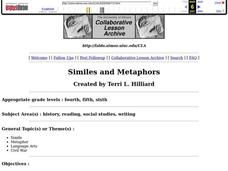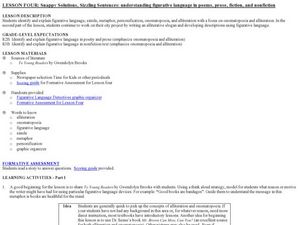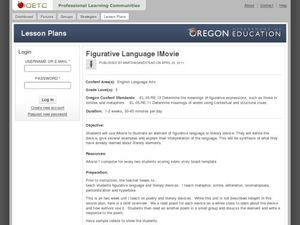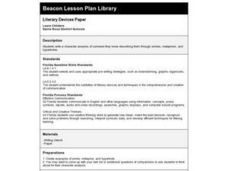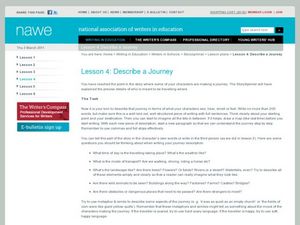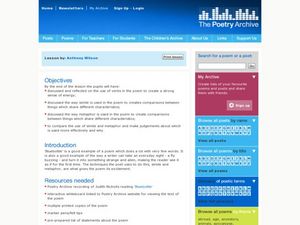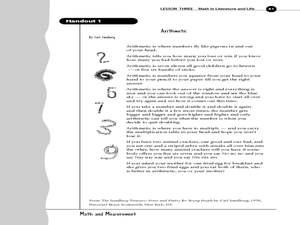Curated OER
Similes and Metaphors
Pupils examine poetry to identify the use of metaphors and similes after the teacher defines what they are. They decide how they can use similes and metaphors to describe different pieces of fruit. Finally, they write poetry about the...
Curated OER
Similes and Metaphors
Use the Civil War and important figures from that period to help your class write poetry. You'll need to create a list of similes and metaphors, but you could also consider having your learners create this the day prior. They will use...
Curated OER
Deciphering the Mechanics of Poetry
After a review of poetic terms, groups are given an object and they create a poem using a simile, a metaphor, internal rhyme, end rhyme, alliteration, and personification. Groups then exchange objects and repeat the process. Consider...
Curated OER
Metaphorical Poetry
Twelfth graders read and discuss poems by Jewel., Sylvia Plath, and Langston Hughes They examine poems for examples of metaphors and similes. After discussing Jewel's poem Lost, they write their own poems. They hold a poetry reading in...
New Class Museum
Lesson: Emory Douglas: Decoding Images and Vocabulary Activity
To better understand the work of Black Panther logo artist Emory Douglas, learners define literary devices. They define a series of words such as metaphor, simile, and assonance, then place an example of that device found in Emory...
Curated OER
Poetry IV--Similes and Metaphors
Middle schoolers solve and write riddles using similes and metaphors. In this similes and metaphors instructional activity, students work in groups to solve descriptive riddles for famous landmarks. Middle schoolers are given...
Curated OER
It's Raining Cats and Dogs! Literary Devices and Figurative Language
Third and fourth graders study literary devices and figurative language. They view a PowerPoint presentation (which you must create) to review hyperbole, idiom, simile, and metaphor. They read and discuss the book There's A Frog in...
Curated OER
Snappy Solutions, Sizzling Sentences
An examination of the figurative language in Gwendolyn Brooks’ To Young Readers challenges your writers to think about the richness of language. Ask your class why Brooks says, “Good books are bandages.” This discussion of alliteration,...
Curated OER
Haiku Wrap Up
Students create a haiku about the land formations they've studied. In this haiku lesson, students identify the metaphor and meaning of a given haiku, brainstorm comparisons for a landform photo as a class and choose one to use in a...
Curated OER
Poetry in Music
Sixth graders look at poetry in music. In this language arts instructional activity, 6th graders listen to and read the lyrics of songs to find the poetic aspects of them. They focus on similes and metaphors and write their own songs...
Curated OER
Figurative Language
What is figurative language, and why do we use it? Introduce your high schoolers to some examples and discuss the importance of including this element in your writing. After studying a text and searching for examples, writers will...
Curated OER
Figurative Language iMovie
In order to understand figurative language, learners read 5 poems, each exemplifying a different literary device. They discuss and write responses to each poem. They then choose one literary device which they will use as the basis...
Curated OER
Literary Devices Paper
Fourth graders write a character analysis of someone they know describing them through similes, metaphors, and hyperboles. They may include themselves and how their person relates to him or her.
Curated OER
Describe a Journey
Students describe the sensory experience of a character's journey in an essay. In this precise details writing lesson, students explain the effects on the senses of weather, time of day, landscape, and other...
Curated OER
ESL Network: Tezen, A Haitian Folktale
Sixth graders brainstorm various types of friendships prior to reading "Tezen," a tale about a young girl's friendship with a fish. After writing story reviews, they work in small groups to create dramatic skits based on the text and...
Curated OER
Musical Poetry
Students analyze lyrics of their favorite songs as examples of alliteration, metaphor, Onomatopoeia, personification, rhyme, and simile to determine the purpose of these devices in poetry. They use their analysis to create a presentation...
Curated OER
The Language of Surprise
Aspiring writers complete and discuss fill-in-the-blank cliché expressions, define cliché as a form of predictable writing, take cliché expressions and turn them into new, unpredictable ones, read poetry that illustrates writer's use of...
Curated OER
Simile Stories
Fourth graders view song lyrics and identify similes in the song text. In this similes lesson, 4th graders define and identify similes on a worksheet. Students write their own similes using various adjectives.
Curated OER
Deciphering the Mechanics of Poetry
Eighth graders study poetic devices and use them in their own writing and apply them when reading poetry. In groups, they describe an item using poetic devices.
Curated OER
Bluebottle
Students read the poem Bluebottle and discuss the use of the simile in the poem. In this Bluebottle poetry lesson, students analyze the use of verbs and the energy created by that use. Students text mark all the similes in...
Curated OER
Review Poetry and the Simile and the Metaphor
Pupils compile a list of the things they look for in a friend. Then they use that information to create a simple poem. Later they illustrate and display their poems.
Curated OER
Tell a Ton of Tall Tales
Elementary schoolers read many tall tales. They create their own tall tale about a specific event of their choosing. They must act the part of the author. This well-designed lesson takes three class sessions to complete, and is...
Curated OER
Math in Literature and Life
Pupils read poems, read phrases, and create a poster for what math is and relate it back to literature. They also discuss the impact math has had on literature.
Curated OER
Haunting Music
Students discover music that was inspired by the spooky and bizarre. In this music of Hector Berlioz and Camille Saint-Saens lesson, students identify elements of music and listen to the Symphonie Fantastique and Danse Macabre....

